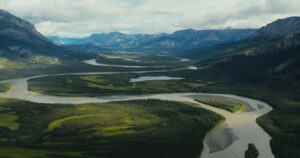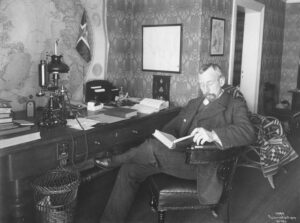“He was our Rembrandt and maybe our Picasso, too,” an Inuit schoolteacher in Tasiilaq, East Greenland, once told me. He was referring to Karale Andreassen, who, in addition to being an artist, was also an ethnographer, a catechist, a writer, a teacher, and a film actor. In other words, a veritable Renaissance man, although one hardly known outside Greenland.
Karale was born in 1890 in the vicinity of Angmagssalik. His birth name was Kavkajik, which means “Snow Bunting” in Greenlandic, but that name was changed to the more pronounceable Karale by Danish officials after he was baptized in 1899. His father was the well-known angakok (shaman) Mitsivarniannga, whose specialty was creating tupilaks.
Initially, these “hell animals,” as explorer-writer Peter Freuchen called them, were compendiums of animal bones and parts of a child’s corpse, but they became grotesque bone, ivory, and driftwood carvings in the early 20th century. Yet whatever it might be made from, a tupilak would come alive by sucking its creator’s genitals (Mitsivarniannga means “Suck Me”), after which it would go after its victim. Usually, that victim would end up with his or her entrails yanked out, but if the victim was strong enough, the tupilak would be sent back to yank the entrails out of its creator.

An Andreassen tupilak. Royal Engravings Collection, Copenhagen
An illustrator of the supernatural
Given his father’s area of expertise, it’s not surprising that Karale — after traveling to Godthaab (now Nuuk) and studying art — became an illustrator of tupilaks. His pen or pencil drawings of these surreal creatures are often rather surreal themselves. They also have a darkly comic aspect not unlike certain Greenlandic folktales. Imagine a grinning human skull atop the skeleton of a bird advancing toward an oblivious hunter. Or imagine a Godzilla-sized polar bear rising from the sea and attacking a kayaker.
Karale made more or less realistic drawings as well. Here’s an example: two parents bent over and grieving beside their deceased son’s burial cairn. Not a single Christian principle occurs in any of his drawings, even though Karale became a catechist (he studied Christianity as well as art in Godthaab) and taught such principles to his fellow East Greenlanders.
Perhaps because he was a Christian, Karale ended up being more devoted than he would otherwise have been to preserving the past traditions of his culture. Thus he became a go-to font of knowledge for ethnographers such as William Thalbitzer and especially Knud Rasmussen, whose Fourth and Seventh Thule Expeditions he participated in. In fact, his drawings as well as some of the ethnographic lore he collected are in Rasmussen’s write-ups of these expeditions.
Like Rasmussen himself, Karale may have embellished some of his material. Consider his legend Kunuk, Kagssagsuk, Ultlivatsiardlo, which appears in Rasmussen’s Posthumous Notes on East Greenland Legends and Myths. This novella-length tale wanders hither and yon in describing the adventures of the three Inuit featured in the title and ends with Kagssagsuk’s formerly difficult son saying to a group of young men: “Amuse yourselves and pet my wife a little…”
Helps pioneer ethologist Niko Tinbergen
But not only ethnographers sought out Karale. As part of the International Polar Year (1932-33), the young Dutch scientist Niko Tinbergen came to East Greenland and lived with him in Kungmiut. Karale became his guest’s guru, teaching him how to paddle a kayak and how to hunt seals as well as telling him about the social relations of his sled dogs.
Tinbergen soon began studying the competitive interactions of these canines himself. He also studied the territoriality and demeanor of snow buntings — could he have been inspired to do this after Karale told him his birth name? Back in Holland, Tinbergen became a well-known animal behaviorist, and in 1973 he shared a Nobel Prize with two other celebrated animal behaviorists, Karl von Frisch and Konrad Lorenz. If he hadn’t been tutored by Karale, he might not have gotten this prestigious award!
Shortly after Tinbergen left Greenland, Knud Rasmussen asked Karale to be his collaborator on a feature film about pre-contact life in East Greenland. Entitled Palos Brudefaerd (The Wedding of Palo), this film turned out to be more or less an amalgam of stories and legends both men had collected. Karale and Rasmussen supervised the shooting, and the German documentary film-maker Friedrich Dalsheim, famed for Insel der Damonen (Island of Demons) and Menschen Im Busch (People in the Bush), served as the film’s director.
As it happens, Karale acted in the film as well. The hero Palo has been stabbed by the villain Samo during a piseq (song duel), and Karale plays the angakok who, by chanting, hissing, and sipping Palo’s blood, brings him back to life. In doing this, he was probably emulating one of his father’s shamanic acts.
The last chapter
Once the film was finished, Rasmussen took Karale to Denmark with him so that he, Karale, could do a voice over in sync with the lip movements of the film’s actors. Since he’d eaten tainted seal meat in Greenland, Rasmussen was already ill, and he died of botulism compounded by influenza and pneumonia on December 21, 1933. Karale himself died on February 22, 1934 of tuberculosis shortly after he completed the synchronization of the film. Somehow it seems fitting that these two like-minded individuals should die in the same place within a very short time of each other.






